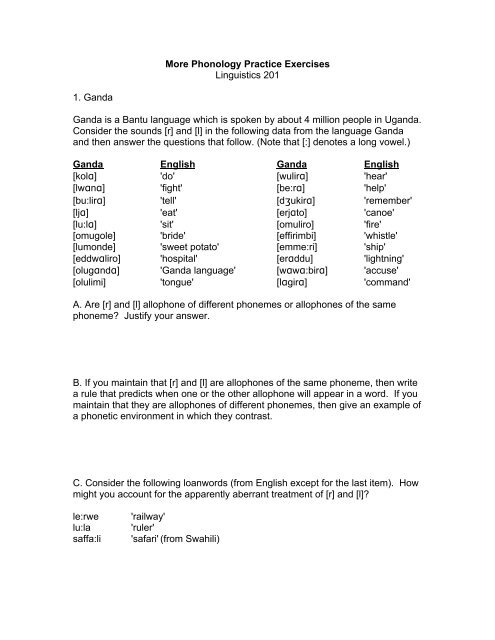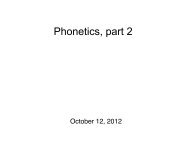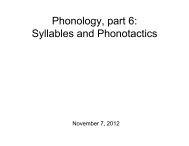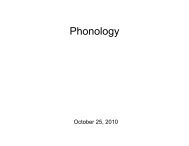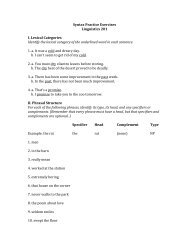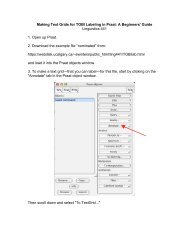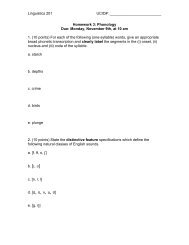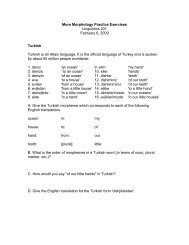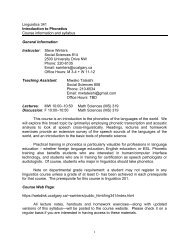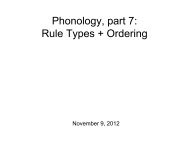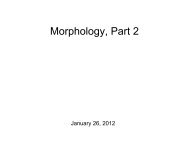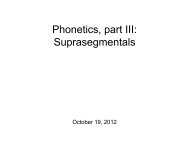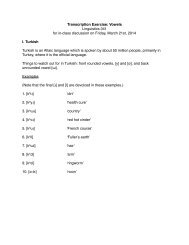More Phonology Practice Exercises Linguistics 201 1. Ganda Ganda ...
More Phonology Practice Exercises Linguistics 201 1. Ganda Ganda ...
More Phonology Practice Exercises Linguistics 201 1. Ganda Ganda ...
- No tags were found...
You also want an ePaper? Increase the reach of your titles
YUMPU automatically turns print PDFs into web optimized ePapers that Google loves.
<strong>More</strong> <strong>Phonology</strong> <strong>Practice</strong> <strong>Exercises</strong><strong>Linguistics</strong> <strong>201</strong><strong>1.</strong> <strong>Ganda</strong><strong>Ganda</strong> is a Bantu language which is spoken by about 4 million people in Uganda.Consider the sounds [r] and [l] in the following data from the language <strong>Ganda</strong>and then answer the questions that follow. (Note that [:] denotes a long vowel.)<strong>Ganda</strong> English <strong>Ganda</strong> English[kolɑ] 'do' [wulirɑ] 'hear'[lwɑnɑ] 'fight' [be:rɑ] 'help'[bu:lirɑ] 'tell' [dʒukirɑ] 'remember'[ljɑ] 'eat' [erjɑto] 'canoe'[lu:lɑ] 'sit' [omuliro] 'fire'[omugole] 'bride' [effirimbi] 'whistle'[lumonde] 'sweet potato' [emme:ri] 'ship'[eddwɑliro] 'hospital' [erɑddu] 'lightning'[olugɑndɑ] '<strong>Ganda</strong> language' [wɑwɑ:birɑ] 'accuse'[olulimi] 'tongue' [lɑgirɑ] 'command'A. Are [r] and [l] allophone of different phonemes or allophones of the samephoneme? Justify your answer.B. If you maintain that [r] and [l] are allophones of the same phoneme, then writea rule that predicts when one or the other allophone will appear in a word. If youmaintain that they are allophones of different phonemes, then give an example ofa phonetic environment in which they contrast.C. Consider the following loanwords (from English except for the last item). Howmight you account for the apparently aberrant treatment of [r] and [l]?le:rwelu:lasaffa:li'railway''ruler''safari' (from Swahili)
2. GasconGascon is a Romance language which is spoken in the Pyrenees region of Spainby about 4,000 people. It is called Aranese in France and is closely related to theOccitan language.Like French, Gascon has nasalized vowels, which are symbolized with a [ ̃] overthe vowel. Gascon also has the voiced bilabial fricative, [β], and the voiced velarfricative, [ɣ].<strong>1.</strong> [brẽn] 'endanger' 10. [ʒuɣɛt] 'he played'2. [dilys] ' Monday' 1<strong>1.</strong> [krãmbo] 'room'3. [taldepañ] 'leftover bread' 12. [eʃaðo] 'hoe'4. [ʃiβaw] 'horse' 13. [gat] 'cat'5. [pũnde] 'to lay eggs' 14. [aβe] 'to have'6. [agro] 'sour' 15. [biɣar] 'mosquito'7. [puðe] 'to be able' 16. [ũmbro] 'shadow'8. [riɣut] 'he laughed' 17. [dudze] 'twelve'9. [noβi] 'husband' 18. [lũŋg] 'long'A. Consider the following pairs of phones:[b] and [β][d] and [ð][g] and [ɣ]Each pair consists of two allophones of the same phoneme. State the rule(s) thataccount(s) for when the basic allophones change into the restricted allophones.B. In what phonetic environment do the nasalized vowels appear? What is thephonological rule that accounts for their appearance?C. Do the rules for (A) and (B) need to be ordered in a phonological derivation ofGascon, or can they apply in any order?


